
Nectosaurus is a genus of thalattosaur which lived during the Late Triassic in what is now California. The type and only known species, Nectosaurus halius, was found in the Hosselkus Limestone and described by John C. Merriam in 1905, making it one of the first thalattosaurians known.

Askeptosaurus is an extinct genus of askeptosauroid, a marine reptile from the extinct order Thalattosauria. Askeptosaurus is known from several well-preserved fossils found in Middle Triassic marine strata in what is now Italy and Switzerland.

Bauria is an extinct genus of the suborder Therocephalia that existed during the Early and Middle Triassic period, around 246-251 million years ago. It belonged to the family Bauriidae. Bauria was probably a herbivore or omnivore. It lived in South Africa, specifically in the Burgersdorp Formation in South Africa.
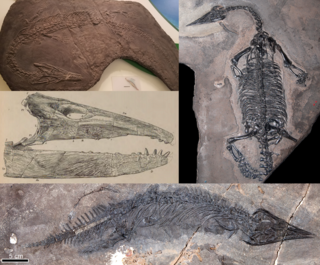
Thalattosauria is an extinct order of marine reptiles that lived in the Middle to Late Triassic. Thalattosaurs were diverse in size and shape, and are divided into two superfamilies: Askeptosauroidea and Thalattosauroidea. Askeptosauroids were endemic to the Tethys Ocean, their fossils have been found in Europe and China, and they were likely semiaquatic fish eaters with straight snouts and decent terrestrial abilities. Thalattosauroids were more specialized for aquatic life and most had unusual downturned snouts and crushing dentition. Thalattosauroids lived along the coasts of both Panthalassa and the Tethys Ocean, and were most diverse in China and western North America. The largest species of thalattosaurs grew to over 4 meters (13 feet) in length, including a long, flattened tail utilized in underwater propulsion. Although thalattosaurs bore a superficial resemblance to lizards, their exact relationships are unresolved. They are widely accepted as diapsids, but experts have variously placed them on the reptile family tree among Lepidosauromorpha, Archosauromorpha, ichthyosaurs, and/or other marine reptiles.
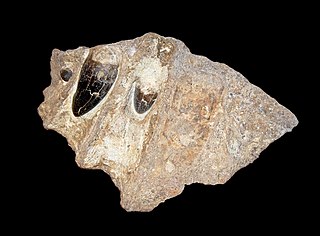
Razanandrongobe is a genus of carnivorous ziphosuchian crocodyliform from the Middle Jurassic of Madagascar. It contains the type and only species Razanandrongobe sakalavae, named in 2004 by Simone Maganuco and colleagues based on isolated bones found in 2003. The remains, which included a fragment of maxilla and teeth, originated from the Bathonian-aged Sakaraha Formation of Mahajanga, Madagascar. While they clearly belonged to a member of the Archosauria, Maganuco and colleagues refrained from assigning the genus to a specific group because the fragmentary remains resembled lineages among both the theropod dinosaurs and crocodylomorphs.

Omphalosaurus is an extinct genus of marine reptile from the Early Triassic to Middle Triassic, thought to be in the order of Ichthyosauria. Most of what is known about Omphalosaurus is based on multiple jaw fragments, ribs, and vertebrae. Specimens of Omphalosaurus have been described from the western United States, Poland, Austria and the island of Spitsbergen off the northern coast of Norway.

Miodentosaurus is a genus of thalattosaurian from the Late Triassic of China. It is one of several thalattosaurs found in the Xiaowa Formation, also known as the Wayao Member of the Falang Formation. The genus name "Miodentosaurus" translates to "Few toothed-lizard" while the species name "brevis" means "short", in reference to its short snout.

Thalattosaurus meaning "sea lizard," from the Attic Greek thalatta (θάλαττα), "sea," and sauros (σαῦρος), "lizard," is an extinct genus of marine reptile in the family Thalattosauroidea. They were aquatic diapsids that are known exclusively from the Triassic period. It was a 2–3 metres (6.6–9.8 ft) long shellfish-eating reptile with paddle-like limbs and a down-turned rostrum occurring in the Lower and Middle Triassic Sulphur Mountain Formation of British Columbia as well as the Upper Triassic Hosselkus Limestone of California. It has gained notoriety as a result of studies on general diapsid phylogeny.

Gobiconodon is an extinct genus of carnivorous mammals belonging to the family Gobiconodontidae. Undisputed records of Gobiconodon are restricted to the Early Cretaceous of Asia and North America, but isolated teeth attributed to the genus have also been described from formations in England and Morocco dating as far back as the Middle Jurassic. Species of Gobiconodon varied considerably in size, with G. ostromi, one of the larger species, being around the size of a modern Virginia opossum. Like other gobiconodontids, it possessed several speciations towards carnivory, such as shearing molariform teeth, large canine-like incisors and powerful jaw and forelimb musculature, indicating that it probably fed on vertebrate prey. Unusually among predatory mammals and other eutriconodonts, the lower canines were vestigial, with the first lower incisor pair having become massive and canine-like. Like the larger Repenomamus there might be some evidence of scavenging.

Venyukovia is an extinct genus of venyukovioid therapsid, a basal anomodont from the Middle Permian of Russia. The type and sole species, V. prima, is known only by a partial lower jaw with teeth. Venyukovia has often been incorrectly spelt as 'Venjukovia' in English literature. This stems from a spelling error made by Russian palaeontologist Ivan Efremov in 1940, who mistakenly replaced the 'y' with a 'j', which subsequently permeated through therapsid literature before the mistake was caught and corrected. Venyukovia is the namesake for the Venyukovioidea, a group of small Russian basal anomodonts also including the closely related Otsheria, Suminia, Parasuminia and Ulemica, although it itself is also one of the poorest known. Like other venyukovioids, it had large projecting incisor-like teeth at the front and lacked canines, although the remaining teeth are simple compared to some other venyukovioids, but may resemble those of Otsheria.
Variodens is an extinct genus of trilophosaur. Fossils have been found from the Emborough Quarries in the Mendip Hills of Somerset, England. These fossils have been uncovered from a Late Triassic fissure fill within Carboniferous-age limestone. The type and only known species is V. inopinatus, named in 1957.
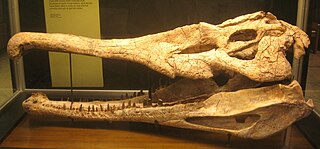
Brachysuchus is an extinct genus of phytosaur known from the late Triassic period of Dockum Group in Texas, United States. It is known from the holotype UMMP 10336 is composed of a skull, lower jaws and partial postcranium and from the associated paratype UMMP 14366, nearly complete skull, recovered from the 'Pre-Tecovas Horizon' in the Dockum Group. It was first named by Case in 1929 and the type species is Brachysuchus megalodon. Its closest relative was Angistorhinus. However, its rostral crest was much smaller than that of Angistorhinus, and the rostrum as a whole is shorter and thicker.

Stenaulorhynchus is an extinct genus of hyperodapedontid rhynchosaur known from the Middle Triassic deposits of Tanganyika Territory, Tanzania. It was found in the Lifua Member of the Manda Formation in the Karoo Supergroup. It was named and first described by Sidney Henry Haughton in 1932. The type species is Stenaulorhynchus stockleyi, a beaked herbivore measuring 1–6 meters in length.

Arcusaurus is an extinct genus of sauropodomorph dinosaur from the Early Jurassic of South Africa.
Libognathus is an extinct genus of procolophonid parareptile from the Late Triassic of Texas. The type and only species, Libognathus sheddi, was named in 1997 from the Cooper Canyon Formation in the fossil-rich Post Quarry, which is found in Garza County. Libognathus was the first definite procolophonid discovered in the southwestern United States, although another possible procolophonid called Chinleogomphius was reported from the southwest before Libognathus was named.
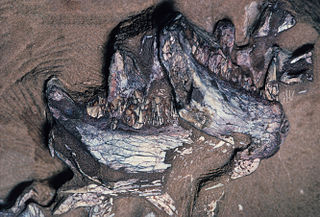
Pegomastax is a genus of heterodontosaurid dinosaur that lived during the Early Jurassic of South Africa. The only known specimen was discovered in a 1966–1967 expedition in Transkei District of Cape Province, but was not described until 2012 when Paul Sereno named it as the new taxon Pegomastax africana. The genus name is derived from the Greek for "strong jaw", and the species name describes the provenance of Africa; it was originally spelled africanus, was corrected to africana to align with the gender of the genus name.
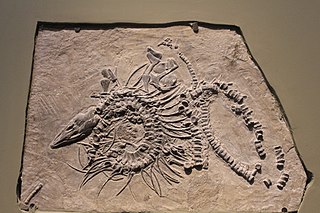
Xinpusaurus is an extinct genus of thalattosaur from the Late Triassic of Guanling in Guizhou, China. Several species have been named since 2000: the type species X. suni along with the species X. bamaolinensis and X. kohi. A 2013 study proposed that all three species are synonymous with each other, in which case X. suni would be the only valid species, although a 2014 study argued that X. kohi was also valid. A fourth species, X. xingyiensis, was described in 2016.
The Sulphur Mountain Formation is a geologic formation of Early to Middle Triassic age. It is present on the western edge of the Western Canada Sedimentary Basin in the foothills and Rocky Mountains of western Alberta and northeastern British Columbia. It includes marine fossils from the time shortly after the Permian-Triassic extinction event.
Bocaconodon is an early mammaliaform genus that lived during the Pliensbachian of Mexico. The type and only species, Bocaconodon tamaulipensis, was named and described in 2008. It is known from a single specimen, a partial right dentary bone preserving two nearly complete molar teeth and the rear portion of a third molar. The specimen was found at the Huizachal Canyon locality, "a Pliensbachian floodplain siltstone in the La Boca Formation".

Kansaignathus is an extinct genus of dromaeosaurid theropod from the Late Cretaceous Yalovach Formation of Tajikistan. The genus contains only one species, the type species, K. sogdianus. The generic name of Kansaignathus comes from near the town of Konsoy where it was discovered and the Greek word "gnathos" meaning "jaw". The specific epithet "sogdianus" is derived from the historical region of Sogdiana, which was an ancient name for the Fergana Valley region where the fossil was discovered. Kansaignathus is known from a single right dentary bone and a few post-cranial bone fragments. It was the first, and so far the only, dinosaur from Tajikistan to be described and named.















